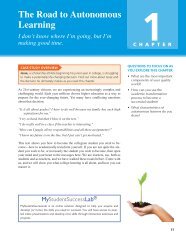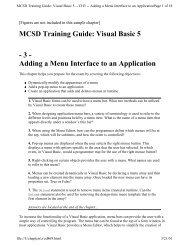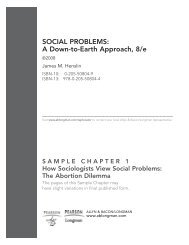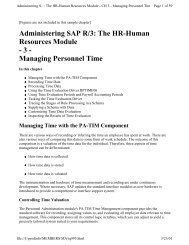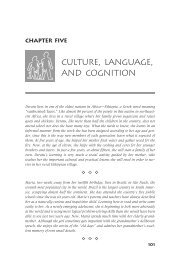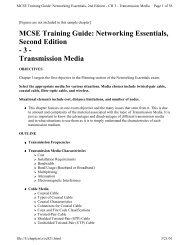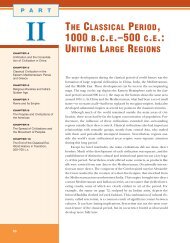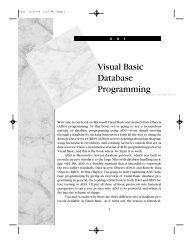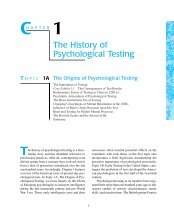Asian Philosophies JOHN M. KOLLER - Pearson
Asian Philosophies JOHN M. KOLLER - Pearson
Asian Philosophies JOHN M. KOLLER - Pearson
Create successful ePaper yourself
Turn your PDF publications into a flip-book with our unique Google optimized e-Paper software.
KOLLMF01_0131951831.QXD 26/6/06 4:16 PM Page i<br />
FIFTH EDITION<br />
<strong>Asian</strong> <strong>Philosophies</strong><br />
<strong>JOHN</strong> M. <strong>KOLLER</strong><br />
Rensselaer Polytechnic Institute<br />
Upper Saddle River, New Jersey 07458
KOLLMF01_0131951831.QXD 26/6/06 4:16 PM Page ii<br />
Library of Congress Cataloging-in-Publication Data<br />
Koller, John M.<br />
<strong>Asian</strong> philosophies / John M. Koller. — 5th ed.<br />
p. cm.<br />
Previously published: Upper Saddle River, N. J. : Prentice Hall, c2002.<br />
ISBN 0-13-195183-1<br />
1. Philosophy, <strong>Asian</strong>. I. Title.<br />
B121.K555 2007<br />
181—dc22<br />
2006013375<br />
Editor-in-Chief: Sarah Touborg<br />
Senior Acquisitions Editor: Mical Moser<br />
Editorial Assistant: Carla Worner<br />
Assistant Marketing Manager: Andrea Messineo<br />
Marketing Assistant: Vicki DeVita<br />
Production Liason: Marianne Peters-Riordan<br />
Manufacturing Buyer: Christina Amato<br />
Art Director: Jayne Conte<br />
Cover Design: Bruce Kenselaar<br />
Cover Illustration/Photo: Wu Wei, “Scholar<br />
Seated Under a Tree”, China. Ink & traces<br />
of colour on silk. 14.7 x 8.25. Chinese and<br />
Japanese Special Fund. Photograph © 2007<br />
Courtesy Museum of Fine Arts, Boston.<br />
Director, Image Resource Center:<br />
Melinda Patelli<br />
Manager, Rights and Permissions:<br />
Zina Arabia<br />
Manager, Visual Research: Beth Brenzel<br />
Manager, Cover Visual Research &<br />
Permissions: Karen Sanatar<br />
Image Permission Coordinator:<br />
Angelique Sharps<br />
Composition/Full-Service Project<br />
Management: Shiny Rajesh/Integra<br />
Software Services<br />
Printer/Binder: R.R. Donnelley & Sons<br />
Credits and acknowledgments borrowed from other sources and reproduced, with permission, in<br />
this textbook appear on appropriate page within text.<br />
Copyright © 2007, 2002, 1998 by <strong>Pearson</strong> Education, Inc., Upper Saddle River, New Jersey 07458.<br />
<strong>Pearson</strong> Prentice Hall. All rights reserved. Printed in the United States of America. This publication<br />
is protected by Copyright and permission should be obtained from the publisher prior to<br />
any prohibited reproduction, storage in a retrieval system, or transmission in any form or by any<br />
means, electronic, mechanical, photocopying, recording, or likewise. For information regarding<br />
permission(s), write to: Rights and Permissions Department.<br />
<strong>Pearson</strong> Prentice Hall is a trademark of <strong>Pearson</strong> Education, Inc.<br />
<strong>Pearson</strong> ® is a registered trademark of <strong>Pearson</strong> plc<br />
Prentice Hall ® is a registered trademark of <strong>Pearson</strong> Education, Inc.<br />
<strong>Pearson</strong> Education LTD. <strong>Pearson</strong> Education North Asia Ltd<br />
<strong>Pearson</strong> Education Singapore, Pte. Ltd <strong>Pearson</strong> Educación de Mexico, S.A. de C.V.<br />
<strong>Pearson</strong> Education, Canada, Ltd <strong>Pearson</strong> Education Malaysia, Pte. Ltd<br />
<strong>Pearson</strong> Education–Japan <strong>Pearson</strong> Education, Upper Saddle River,<br />
<strong>Pearson</strong> Education Australia PTY, Limited New Jersey<br />
10987654321<br />
ISBN 0-13-195183-1
KOLLMF01_0131951831.QXD 26/6/06 4:16 PM Page iii<br />
To My Daughter<br />
Christy Koller<br />
And in Memory of My Son<br />
John Thomas Koller
KOLLMF01_0131951831.QXD 26/6/06 4:16 PM Page iv
KOLLMF01_0131951831.QXD 26/6/06 4:16 PM Page v<br />
Contents<br />
Preface xiii<br />
Introduction xv<br />
PART I<br />
SOUTH ASIAN PHILOSOPHIES<br />
CHAPTER 1<br />
Historical Perspectives 4<br />
Historical Overview 4<br />
Dominant Features 8<br />
Review Questions 13<br />
Further Reading 13<br />
CHAPTER 2<br />
Vedas and Upanishads 15<br />
Indus Culture 15<br />
Vedic Thought 16<br />
Origins of Existence 18<br />
The Upanishads 21<br />
Quest for Brahman 22<br />
Quest for the Ultimate Self (Atman) 23<br />
Tat Tvam Asi 27<br />
v
KOLLMF01_0131951831.QXD 26/6/06 4:16 PM Page vi<br />
vi Contents<br />
Review Questions 28<br />
Further Reading 28<br />
CHAPTER 3<br />
The Jain Vision 30<br />
Overview 30<br />
Mahavira 31<br />
Karmic Bondage 31<br />
Reality 32<br />
Kinds of Karma 34<br />
Way of Liberation 35<br />
Knowledge 38<br />
Faith 39<br />
Conduct 40<br />
Impact of Jain Thought 42<br />
Review Questions 43<br />
Further Reading 43<br />
Notes 44<br />
CHAPTER 4<br />
Buddhism: The Basic Teachings 45<br />
Overview 46<br />
The Buddha 47<br />
Quest for Enlightenment 50<br />
Enlightenment 51<br />
The Noble Fourfold Truth 53<br />
The First Noble Truth 53<br />
The Second Noble Truth 56<br />
The Third Noble Truth 57<br />
The Fourth Truth: The Noble Eightfold Path 58<br />
Review Questions 62<br />
Further Reading 62<br />
Notes 63<br />
CHAPTER 5<br />
Interdependent Arising and the Development<br />
of Mahayana 64<br />
Conditioned Existence 64<br />
Mindfulness 72
KOLLMF01_0131951831.QXD 26/6/06 4:16 PM Page vii<br />
Perfection of Wisdom and Rise of Mahayana 77<br />
Reading the Texts 77<br />
Diamond Sutra 80<br />
Heart Sutra 82<br />
Review Questions 85<br />
Further Reading 85<br />
Notes 86<br />
Contents vii<br />
CHAPTER 6<br />
Madhyamaka and Yogacara 88<br />
Overview of Madhyamaka:The Middle Way Tradition 88<br />
Nagarjuna’s Method 89<br />
Yogacara 96<br />
Nature and Function of Consciousness 97<br />
Knowledge of Reality 102<br />
Review Questions 106<br />
Further Reading 106<br />
Notes 107<br />
CHAPTER 7<br />
Society and the Individual 109<br />
Bhagavad Gita 109<br />
Human Aims 111<br />
Social Classes 114<br />
Life-Stages 116<br />
Review Questions 116<br />
Further Reading 117<br />
Notes 117<br />
CHAPTER 8<br />
Self and the World: Sankhya-Yoga 118<br />
Causality 119<br />
Evolution of the World 121<br />
Yoga: The Way of Discipline 124<br />
Forces of Bondage 125<br />
Techniques of Yoga 126<br />
Review Questions 129<br />
Further Reading 129<br />
Notes 130
KOLLMF01_0131951831.QXD 26/6/06 4:16 PM Page viii<br />
viii Contents<br />
CHAPTER 9<br />
Knowledge and Reality:<br />
Nyaya-Vaisheshika 131<br />
The Problem of Knowledge 131<br />
Perceptual Knowledge 132<br />
Inference 134<br />
Comparison 136<br />
Testimony 137<br />
Objects of Knowledge: The Vaisheshika Categories 137<br />
The Knower 140<br />
Review Questions 140<br />
Further Reading 141<br />
CHAPTER 10<br />
Self and Reality: Mimamsa and Vedanta 142<br />
Mimamsa 142<br />
Vedanta 145<br />
Shankara’s Nondualism 146<br />
Appearance and Reality 148<br />
The Qualified Nondualism of Ramanuja 153<br />
The Dualistic Vedanta of Madhva 155<br />
Review Questions 156<br />
Further Reading 156<br />
Notes 157<br />
CHAPTER 11<br />
Theistic Developments 158<br />
Vishnu 159<br />
Krishna 161<br />
Kali 163<br />
Shiva 165<br />
Review Questions 168<br />
Further Reading 168<br />
CHAPTER 12<br />
Islam 170<br />
Introduction 170<br />
Basic Teachings of Islam 171
KOLLMF01_0131951831.QXD 26/6/06 4:16 PM Page ix<br />
Development of Sufi Thought 173<br />
The Sufi Path 177<br />
Interaction Between Muslims and Hindus 178<br />
Religion and Politics 182<br />
Review Questions 183<br />
Further Reading 184<br />
Notes 185<br />
CHAPTER 13<br />
Tradition and Modernity 186<br />
Gandhi 187<br />
Aurobindo 188<br />
Iqbal 191<br />
Radhakrishnan 193<br />
Review Questions 195<br />
Further Reading 196<br />
Notes 197<br />
PART II<br />
PHILOSOPHIES OF EAST ASIA<br />
Contents ix<br />
CHAPTER 14<br />
Historical Overview of East <strong>Asian</strong><br />
<strong>Philosophies</strong> 202<br />
Pre-Confucian China 203<br />
Confucianism 203<br />
Daoism 205<br />
Moism 205<br />
School of Names 206<br />
Divination and Cosmology 206<br />
Legalism 208<br />
Synthesis 208<br />
Buddhism 209<br />
Korean Philosophy 210<br />
Japanese Philosophy 211<br />
Neo-Confucianism 212<br />
Basic Characteristics 213<br />
Review Questions 215<br />
Further Reading 215
KOLLMF01_0131951831.QXD 26/6/06 4:16 PM Page x<br />
x Contents<br />
CHAPTER 15<br />
Confucianism: The Thought of Confucius 217<br />
Confucius 217<br />
Human-heartedness (Ren) 220<br />
Propriety (Li) 221<br />
Filiality (Xiao) 223<br />
Rightness (Yi) 223<br />
Rectification of Names (Zheng Ming) 224<br />
Governing by Virtue 224<br />
Review Questions 229<br />
Further Reading 229<br />
Notes 230<br />
CHAPTER 16<br />
Development of Confucianism: Mengzi,<br />
Xunzi, and Dong Zhongshu 231<br />
Challenges to Confucian Thought 231<br />
Mengzi 233<br />
Xunzi 237<br />
Dong Zhongshu and a New Form of Confucianism 239<br />
Review Questions 241<br />
Further Reading 241<br />
Notes 242<br />
CHAPTER 17<br />
Daoism: The Daodejing 243<br />
Laozi 243<br />
The Dao and Its Functions 247<br />
Review Questions 250<br />
Further Reading 251<br />
CHAPTER 18<br />
Zhuangzi’s Daoism 252<br />
Zhuangzi 252<br />
Relativity of Distinctions 254<br />
Complementariness of Opposites 257<br />
Argument from Perspectives 258<br />
Argument from Skepticism 259
KOLLMF01_0131951831.QXD 26/6/06 4:16 PM Page xi<br />
Review Questions 262<br />
Further Reading 262<br />
Notes 263<br />
Contents xi<br />
CHAPTER 19<br />
Chinese Buddhism 264<br />
Introduction from Central Asia and India 265<br />
Translations and Interpretations 266<br />
Tiantai 269<br />
Huayan 271<br />
Chan 273<br />
Pure Land (Jingtu) 274<br />
Review Questions 276<br />
Further Reading 276<br />
Notes 277<br />
CHAPTER 20<br />
Neo-Confucianism: The Grand Harmony 278<br />
The Buddhist Challenge 278<br />
Neo-Confucian Beginnings 279<br />
Zhou Dunyi 281<br />
Cheng Hao and Cheng Yi 283<br />
Zhu Xi 287<br />
The Idealism of Lu Xiangshan and Wang Yangming 291<br />
Wang Yangming 292<br />
Dai Zhen 295<br />
Review Questions 296<br />
Further Reading 296<br />
Notes 297<br />
CHAPTER 21<br />
Korean Philosophy 299<br />
Introduction 299<br />
Wonhyo 300<br />
Chinul 301<br />
Korean Neo-Confucianism 304<br />
Yi T’oegye 305<br />
Yi Yulgok 306<br />
Review Questions 308
KOLLMF01_0131951831.QXD 26/6/06 4:16 PM Page xii<br />
xii Contents<br />
Further Reading 308<br />
Notes 308<br />
CHAPTER 22<br />
Japanese Philosophy 309<br />
Overview 309<br />
Tendai 310<br />
Pure Land 311<br />
Zen 312<br />
Dogen 313<br />
Indian and Chinese Foundations 314<br />
Daoist Influences 316<br />
Aims of Zen 317<br />
Zazen 319<br />
Koan Practice 322<br />
Zen Teachings 324<br />
Ox-Herding: Stages of Practice 325<br />
Review Questions 332<br />
Further Reading 332<br />
Notes 333<br />
CHAPTER 23<br />
Recent Thought 335<br />
Kang Youwei 336<br />
Zhang Dongsun 338<br />
Xiong Shili 339<br />
Fung Yu-lan 342<br />
Nishida Kitaro 345<br />
Post-Mao Thought 347<br />
Review Questions 350<br />
Further Reading 351<br />
Notes 352<br />
Glossary 353<br />
Pronunciation Guide 357<br />
Index 360
KOLLMF01_0131951831.QXD 26/6/06 4:16 PM Page xiii<br />
Preface<br />
What are the main ideas that have shaped <strong>Asian</strong> cultures? What are the<br />
fundamental values that have guided the lives of <strong>Asian</strong> peoples over the<br />
millennia? How have the great thinkers of Asia thought about these ideas<br />
and values? This book is intended to help answer these questions, enabling<br />
us to understand the principal philosophies of the great <strong>Asian</strong> traditions.<br />
Basic human ideas and values derive from answers to fundamental questions<br />
about existence and human life. People everywhere, whether <strong>Asian</strong> or<br />
Western, seek to answer the same basic questions:Who am I? What is real? How<br />
do we come to know something? How should we relate to others? What is the<br />
right thing to do? What is good? However, these questions arise in different<br />
contexts and assume different forms for people living at different times and in<br />
different places, and the answers given vary accordingly. But these questions,<br />
sometimes arising out of wonder, and sometimes arising out of human suffering<br />
and the efforts to improve the conditions of human existence, are questions that<br />
every reflective person seeks to answer. It is these questions and their answers<br />
that provide the fundamental ideas and values that guide the development of<br />
whole cultures as well as the lives of individual persons.<br />
By studying the great philosophical traditions of Asia it is possible for us to<br />
understand these traditions’ carefully considered answers to these questions,<br />
answers that are supported by profound insights and good reasons. Because<br />
these answers have guided the thought and action of the peoples of Asia over<br />
the centuries, they provide the basic clues to the guiding ideas and values of<br />
<strong>Asian</strong> societies today.And in today’s world, where the very future of humankind<br />
xiii
KOLLMF01_0131951831.QXD 26/6/06 4:16 PM Page xiv<br />
xiv Preface<br />
depends upon understanding and cooperation among people with diverse<br />
values and ideas, it is imperative that these values and ideas be understood.<br />
As each of us tries to creatively develop our own personal philosophy we<br />
can benefit enormously from an understanding of the different ways that the<br />
basic questions of life have been answered by the great thinkers in the <strong>Asian</strong><br />
traditions.<br />
The fifth edition has been reorganized into two equal parts on South<br />
Asia and East Asia, and there are new chapters on Korean thought, and<br />
Chinese Buddhism; there is more on Mahayana, Confucian, Daoist, and<br />
Japanese thought; the end-of-chapter readings are updated; Chinese terms<br />
are now in the more widely used Pinyin form; and the glossary has been<br />
expanded.<br />
ACKNOWLEDGMENTS<br />
I would like to express appreciation to the many scholars, too numerous to<br />
name, whose interpretive studies I have used. I also wish to thank the people<br />
who have contributed to the writing of this book. These include Roger Ames,<br />
David Burke, Chung-ying Cheng, Eliot Deutsch, Dewitt and Dorothy<br />
Ellinwood, Hope Fitz, Premchand Gada, Robert Garvin, Bina Gupta, Louis<br />
Hammer, Derek Heyman, Frank Hoffman, Kenneth Inada, David Kalupahana,<br />
Joel Marks, G. Mishra, Richard Olmsted, K. H. Parekh, Rama Rao Pappu, Joel<br />
Smith, Wei-ming Tu, Madhu Wangu, Theodore Wright, students who have used<br />
earlier editions, friends and colleagues at Rensselaer, especially those in the<br />
Department of Philosophy, Psychology, and Cognitive Science, as well as the<br />
reviewers of previous editions: Clyde Ebenreck, Ashok Malhotra, Gerald<br />
Poliks, Dennis Rohatyn, and Paul C. L.Tang. I also wish to express appreciation<br />
for the support provided by Rensselaer Polytechnic Institute and by the Jain<br />
Foundation of North America.<br />
I am especially grateful for the love and support of my wife, Mimi<br />
Forman.<br />
John M. Koller<br />
Great Neck, New York
KOLLMF01_0131951831.QXD 26/6/06 4:16 PM Page xv<br />
Introduction<br />
PHILOSOPHICAL QUESTIONS<br />
Philosophical questions arise out of reflection on experience. Experiencing<br />
sorrow and grief, we ask, What is suffering? Experiencing pleasure and joy, we<br />
ask,What is happiness? Reflecting on the difference between waking experience<br />
and dreaming experience, we ask,What is real? Reflecting on mistaken claims to<br />
know something, we ask, What is knowledge? Reflecting on our experience of<br />
hurting others by our actions and on our own suffering caused by the actions of<br />
others, we ask, What are the right and wrong ways of action? And reflecting on<br />
our own struggles to achieve personal identity and give meaning to our life, we<br />
ask, Who am I? These questions, the fundamental questions of philosophy, are<br />
important because philosophers everywhere understand that the unexamined<br />
life is not worth living, and that philosophical reflection will show how life should<br />
be lived. They are also important because their answers, as incorporated in basic<br />
human practices, ultimately determine the value and meaning of life.<br />
<strong>Asian</strong> philosophy, for the most part, unlike much modern Western<br />
philosophy, has not sharply separated thought from practice and has tended<br />
to see the conceptual and the spiritual as closely related. <strong>Asian</strong> philosophical<br />
thought, like Western, is self-critical, is concerned with conceptual analysis,<br />
and emphasizes good arguments. But <strong>Asian</strong> philosophy also tends to emphasize<br />
insight into and understanding of reality and its importance as a guide to<br />
life. Hinduism, Jainism, Buddhism, Confucianism, and Daoism, for example,<br />
are all ways of practice as well as philosophies or ways of thought. Their philosophical<br />
dimensions have grown out of reflections on practice. At the same<br />
xv
KOLLMF01_0131951831.QXD 26/6/06 4:16 PM Page xvi<br />
xvi Introduction<br />
time, philosophical presuppositions and reflections have given rise to and<br />
guided these ways of practice.This intimate interrelatedness of philosophy and<br />
practice is one of the reasons why philosophy has been held in high esteem<br />
throughout Asia and why it is seen as relevant and important to everyday life.<br />
Because <strong>Asian</strong> philosophical traditions are different in important<br />
ways, the Western reader should attempt to consider them in their own<br />
contexts and in terms of their own merits. Often they do not fit neatly into<br />
modern Western intellectual categories, which tend to divorce thought from<br />
practice and philosophy from religion. Indeed, one of the main challenges<br />
to understanding <strong>Asian</strong> thought is see where it is like and where it is unlike<br />
Western thought.<br />
SOUTH ASIAN PHILOSOPHIES<br />
India is famous for the high regard it accords the seeker of wisdom and for<br />
its reverence and respect for wise persons. Three thousand years ago, the<br />
sages of India were pondering the questions, What is the Self? and What is<br />
the nature of ultimate reality? Pursuing these two questions, they came to<br />
the realization, twenty-five hundred years ago, that the innermost Self is one<br />
with the ultimate reality. The immediate practical problem arising from this<br />
discovery was that of how one could come to know and to realize this inner<br />
Self and thereby become one with the very essence of the universe. The<br />
theoretical problems raised by this discovery centered on the difficulty of<br />
relating the multiplicity and diversity of experienced reality with the sages’<br />
insight into the unity of all existence and the difficulty in ascertaining how<br />
knowledge of such an ultimate reality could be achieved. Reflection on these<br />
issues led to questions about the basis of morality, the nature and function<br />
of society, the means of valid knowledge, the principles of logic, the nature of<br />
the self, and the means of self-realization.<br />
As Indian thinkers reflected on these fundamental questions, they often<br />
disagreed with each other. Their differing insights and understandings led to<br />
the establishment of a variety of philosophical traditions, many of them continuing<br />
to this day. Although the Vedanta tradition is in agreement with the sages<br />
who declared innermost Self and ultimate reality identical, other traditions<br />
reject this vision of reality. Some traditions, like Nyaya and Vaisheshika, are<br />
frankly pluralistic, while others, like Sankhya and Yoga, are dualistic. The Jain<br />
and Buddhist traditions, though they disagreed with each in significant ways,<br />
both rejected the authority of the Vedas, and the existence of God, while<br />
emphasizing the importance of yogic discipline. The Carvakans, sometimes<br />
called Lokayatas, were materialists, denying the existence of God, soul, and any<br />
kind of life after death.<br />
Despite this diversity of philosophical views, there has been widespread<br />
agreement that the self-discipline of yoga is needed to achieve the total<br />
integration of life and to attain life’s highest goals. According to the Bhagavad<br />
Gita, an extremely influential Hindu text, this discipline is available to all<br />
persons when it is channeled through the activities of worship and devotion, the<br />
activities of work, and the activities of knowledge and concentration. From
KOLLMF01_0131951831.QXD 26/6/06 4:16 PM Page xvii<br />
Introduction xvii<br />
a Hindu perspective, these paths of self-discipline are simply the philosophical<br />
wisdom of the ages being put into practice by the people.<br />
There has also been widespread agreement concerning the importance<br />
of living morally, fulfilling one’s moral duties, especially the duty to avoid<br />
hurting other living beings. At least part of the reason why living a moral life<br />
is so important is the widespread agreement that all human actions are governed<br />
by the principle of karma, which says, roughly, that because every<br />
action inevitably produces its effects, therefore it is our actions that make us<br />
the kinds of persons we become. To become good we must engage in morally<br />
good actions. Performing bad actions will make us into bad persons. Jainism,<br />
a tradition more than three thousand years old, epitomizes the importance<br />
of conjoining the ways of virtuous living and yogic meditation in order to<br />
overcome human suffering.<br />
According to Buddhism, a tradition that originated in India twenty-five<br />
hundred years ago, the basic problem of life is that of overcoming suffering.<br />
The essential teachings of the Buddha revolve around questions being asked<br />
by many thinkers of his time, namely, What is suffering? On what conditions<br />
does it depend? How can these conditions be eliminated? What path should<br />
one follow to eliminate suffering?<br />
These questions led to inquiries into the nature of the self that suffers<br />
and the causes of suffering, giving rise to philosophical views of self and reality.The<br />
problems of justifying the claims made about the nature of the self and<br />
the nature of reality led, in turn, to theories of logic and knowledge. The problem<br />
of how to overcome suffering led to the development of understanding<br />
about morality and mental discipline and a new understanding of consciousness.<br />
Thus, the eminently practical problems of finding ways to overcome<br />
suffering provoked the reflections that constitute Buddhist, Jain, and Hindu<br />
philosophical traditions.<br />
EAST ASIAN PHILOSOPHIES<br />
The three enduring philosophical traditions of East Asia are Confucianism,<br />
Daoism, and Buddhism. Confucianism, which began with the teachings of<br />
Confucius in the sixth century BCE, incorporated important features of competing<br />
traditions, such as Legalism, Moism, the School of Names, and Yin Yang<br />
thought, as it developed. Daoism, with its emphasis on nature and spontaneity,<br />
began at about the same time and provided a counterbalance to Confucian<br />
thought. It also provided much of the philosophical framework and vocabulary<br />
necessary for Buddhism to take hold in China, where it become the third great<br />
philosophical tradition fifteen hundred years ago.<br />
Before the development of Chinese Buddhism, philosophical thought<br />
was concerned primarily with the ways of moral, social, and political life or with<br />
understanding the ways of nature. The central problems of Chinese philosophy<br />
are reflected in the Confucian question, How can human beings and human<br />
society achieve their fullest possible development? and in the Daoist question,<br />
How can humans achieve harmony with nature? Some two thousand years ago,<br />
Confucianism became the official ideology of China, with Confucian writings
KOLLMF01_0131951831.QXD 26/6/06 4:16 PM Page xviii<br />
xviii Introduction<br />
constituting the core curriculum of the imperial university system and the basis<br />
of the civil service exams. Knowing Confucian thought was an indispensable<br />
requirement for government service, making Confucianism the basis for social<br />
and political life.<br />
As philosophy developed in China, there was an increasing tendency to<br />
see human nature in terms of natural processes.To the extent that this identification<br />
took place, the problem of achieving harmony with nature was the<br />
problem of being in harmony with oneself. In turn, being in harmony with<br />
oneself was regarded as the necessary basis for achieving a harmony<br />
with other persons. Being in harmony with oneself, in harmony with humanity,<br />
and in harmony with Heaven and Earth is the highest good in Chinese philosophy.<br />
Because human nature is seen as essentially moral, the dominant<br />
concern of Confucian and Neo-Confucian philosophy has been moral. The<br />
Confucian questions, How can I be good? and What is the basis of goodness?<br />
are basic questions throughout the history of East <strong>Asian</strong> philosophy, as is the<br />
Daoist question, How can I achieve harmony with the Dao?<br />
The development of Chinese Buddhism in the fourth and fifth centuries<br />
CE fostered an interest in metaphysical questions abut the nature of the self<br />
and reality and in the relationship of knowledge to liberation, causing<br />
Confucian and Daoist thought to become involved with these issues. At the<br />
same time, Confucian concerns with fostering the way of humanity and social<br />
harmony and Daoist concerns with the workings of nature allowed Buddhism<br />
to develop in new ways in East Asia.<br />
INTERACTIONS AND SHARED CONCERNS<br />
Although Buddhism was the main vehicle of interaction between Indian<br />
thought and the thought of East and Southeast Asia, it turned out that the<br />
influence was largely one way, from India to the rest of Asia, with India experiencing<br />
little influence from the rest of Asia. The most notable external influences<br />
on Indian thought came from the Greeks, who came to India with<br />
Alexander the Great, and from the Muslims, who came to India between the<br />
eighth and eleventh centuries and who came to rule India from the thirteenth<br />
to the nineteenth centuries.<br />
There are many differences among the philosophies of South and East<br />
Asia, but they all share the practical concern of how to live better. There is<br />
shared agreement that the development of moral virtue is an important<br />
ingredient of a successful way of life, and that the well-being of the individual<br />
cannot be separated from the well-being of the family and the larger social<br />
community. They also agree that to follow the way to a better life we must<br />
have a deep understanding of ourselves and the world.<br />
Because it is concerned with the fundamental thought and practices<br />
of the <strong>Asian</strong> peoples, philosophy has been of primary importance in <strong>Asian</strong><br />
cultures. Therefore, in order to understand the life and the attitudes of the<br />
peoples of Asia, it is necessary to understand their philosophies. And<br />
in order to understand their philosophies, it is necessary to look at the<br />
traditions in which these philosophies developed and through which they<br />
continue to nourish the cultures of Asia.
KOLLMF01_0131951831.QXD 26/6/06 4:16 PM Page xix<br />
xix
KOLLMF01_0131951831.QXD 26/6/06 4:16 PM Page xx<br />
xx



